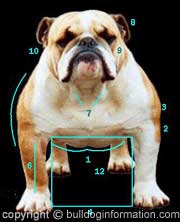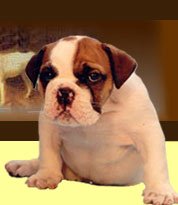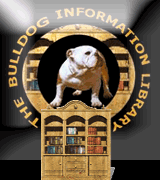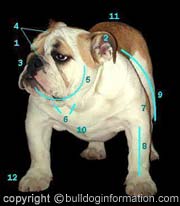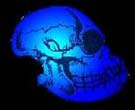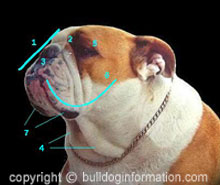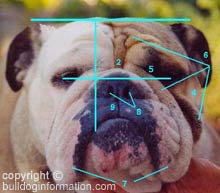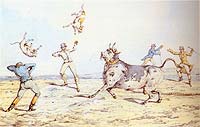The Standard and its relation to Bull baiting
he tried to keep as close as possible to the ground (this was called "playing-low"), so as to get in under the bull's horns, the Bulldog's short forelegs (6) and out-turned elbows (2) facilitating this. If he failed in his objective, he ran great risk of being furiously trampled upon or the bull might succeed in slipping his horns under the dog's belly, and send him soaring up into the air.
During the bull-bait, a well-bred Bulldog invariably attacked the bull in front, directly going for the nose or lip. During this attack
correct neck arched at the back, presenting a convexe line. Short, but very thick and strong
The specimens with short thick necks (10) and short
backs, will ribbed up (1), stood the best chance the survive when falling back on the ground.
The Bulldog's muscular thighs and hind legs, which were long in proportion to the forelegs (11), as well as the placement of his stifles, hocks and pasterns and his arched loins, allowed him to spring up to reach the bull's head, when it went up in a vain attempt to place it out of reach of his assailant.
Moreover, the bulldog's light hindquarters, small tucked-up belly, and shapely cut-up all played their part by relieving him of useless weight.
The characteristic extension of the lower jaw beyond the upper (5) allowed the dog, in running directly from the front (as all good Bulldogs do in making their attack) to grasp the muzzle with greater certainty then would be the case it the mouth were level, and gave a vise-like grip which was increased by the
turn-up and the setting of the canine teeth in the wide and powerful-jaws. A wry-jawed animal would have been shaken off in no time, and such a flaw
is still rightly accounted a very serious fault.
Correct turp-up
with typical basket-handle
arched mandible
The reason for this is that, the larger the head the greater the area for the attachment of those all-important muscles that actuate the jaws. The typical lay-back (1), with the consequent recession of the nose (3)allowed the dog to maintain his hold without impeding his breathing.
When the blood poured from the wound he had inflicted and the dog's face was bespattered with slimy froth, he was not blinded, for the widely set eyes (5) and the deep furrow (2) between them served as a channel to draw the fluids away. The stop kept them from running over his nostrils; here they were diverted into the creases formed by the wrinkles of the foreface, and eventually
If the jaws were level and the dog down faced, the rapidly swelling portion of the bull's flesh on which the Bulldog fastened, as well as his own upper lip, would be pressed against his nostrils; he would be unable to breathe freely and would soon be compelled to let go.
they reached the dog's flews and chops, where they combined with this own sweat and saliva and dripped away from the extremities. This is the real purpose of the flews, and they are always more pronounced on animals that, like the Bulldog, were originally bred for battle.
This was more likely to happed in the case of very heavy dogs and particularly those which were "beefy" in their hindquarters, when they should have been "comparatively narrow at the loins", as the British Standard states.
The large head that the Standard requires, but which some believe to be the cause of so much trouble and mortality at parturition, has always been regarded as an essential Bulldog feature.
In subsequent revisions of the Standard the weight of the Bulldog has been raised. Surely this is a serious mistake and it is to be hoped that this is not merely the prelude to a further upgrading! Very heavy dogs are quite unsuitable for bull-baiting, as our ancestors were well aware. It is not only that they lack agility; excessive weight would almost certainly cause the flesh to which the dog fastened to be torn away, the heavy animal caming down 'plomp' after having been tossed maybe thirty or forty feet high.
In conclusion, if we have correctly interpreted the Standard in its relation to bull-baiting, we may say that a judge will not go far wrong in placing the exhibits after he has examined them carefully in the light of the four following questions: "Is the head correct?" "Are the eyes dark?" "Is the tail according to Standard?" and, "Could this dog bait a bull?" It is no use retorting that he will never be called upon to do so. He could only do so if the conforms to the Standard.
Reference:
The New Complete Bulldog, by Col. Bailey C. Hanes.
It not infrequenly happened that as the bull shook and tossed his head in frantic efforts to dislodge the aggressor, the piece of flesh that the dog had gripped was torn bodily out and the Bulldog fell with it to the ground, only to find retribution under his adversary's hoofs.
.
.
.
Belly well tucked-up
behind the ribs
Chest and brisket lack depth,
lack of tuck-up at loin
Original idea, design and development by C. Marien-de Luca. No part of bulldoginformation.com may be copied, distributed, printed or reproduced on another website without the owner's written permission. Please feel free to link from your site to any of the pages on this website in a non-frame presentation only.


